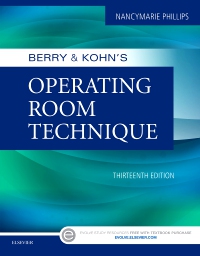
Berry & Kohn's Operating Room Technique - Elsevier eBook on VitalSource, 13th Edition
Elsevier eBook on VitalSource

For over 50 years, Berry & Kohn’s Operating Room Technique, 13th Edition has been the text educators choose to help students understand basic surgical principles and techniques. Highly readable, accurate, and comprehensive, it clearly covers the "nuts and bolts" of surgical techniques in a step-by-step format that makes it easy for students to learn how to effectively apply basic principles to clinical practice. Expert author Nancymarie Phillips emphasizes the importance of teamwork throughout, with practical strategies and examples of how cooperation among perioperative caregivers contributes to positive patient care outcomes. With a strong focus on the physiologic, psychologic, and spiritual considerations of perioperative patients, this updated and expanded new edition gives students the knowledge they need to plan and implement comprehensive, individualized care.
Newer Edition Available
Berry & Kohn's Operating Room Technique - Elsevier eBook on VitalSource
-
- Enhanced! A strong safety focus includes increased coverage of malignant hyperthermia, bullying and zero-tolerance policies, airway fire, verbal orders, medications, patient identification, pharmacology for bariatric patients, calculating blood loss, National Patient Safety Goals, and more.
- NEW! "Pros and Cons" boxes provide the positive and negative aspects of specific perioperative practices, allowing providers to better understand their choices in patient care.
- Step-by-step coverage of the foundations of surgical techniques enables students to effectively apply basic principles to practice.
-
Improved! Emphasis on quality gives you the most current information on magnet status, performing an effective 5-minute assessment, the nurse practitioner as first assistant, accurately marking specimens, patient positioning, surgical conscience, and working with outsiders inside the OR environment.
- Detailed information on the fundamentals of perioperative nursing and surgical technology roles enhances students’ understanding of basic surgical principles and techniques.
- Emphasis on teamwork among perioperative caregivers encourages cooperation in attaining positive patient care outcomes.
- NEW! Coverage of new equipment, including: sponge-counting machines, Lapra-TY, silver-infused dressings, neat suture books, and more.
- In-depth discussions of patients with special needs related to age or health status help students learn how to develop a plan of care tailored to the unique care parameters of all patients.
- Focus on the physiologic, psychologic, and spiritual considerations of perioperative patients gives students the knowledge they need to plan and implement comprehensive, individualized care.
- Content on perioperative patient care for both inpatient and ambulatory procedures highlights key considerations for each setting, as well as for individual surgical procedures.
- Chapter outlines with page numbers, chapter objectives, and key terms and definitions help students quickly find important information and focus their study time.
- New illustrations reflect new and changing perioperative procedures, and provide students with key safety information like how to maintain a sterile field, gown, and glove.
- Enhanced TEACH manual and extensive Evolve resources help you teach more effectively and maximize classroom learning. All Evolve materials are highlighted within the text.
- NEW! Body Spectrum added to Evolve site to help students review anatomy and physiology.
- Additional and updated tables and boxes call attention to the most important concepts from the text.
- References highlight the evidence-based practice approach used throughout the text.
-
- Enhanced! A strong safety focus includes increased coverage of malignant hyperthermia, bullying and zero-tolerance policies, airway fire, verbal orders, medications, patient identification, pharmacology for bariatric patients, calculating blood loss, National Patient Safety Goals, and more.
- NEW! "Pros and Cons" boxes provide the positive and negative aspects of specific perioperative practices, allowing nurses to better understand their choices in patient care.
- Improved! Emphasis on quality gives you the most current information on magnet status, performing an effective 5-minute assessment, the nurse practitioner as first assistant, accurately marking specimens, patient positioning, surgical conscience, and working with outsiders inside the OR environment.
- NEW! Coverage of new equipment, including: sponge-counting machines, Lapra-TY, silver-infused dressings, neat suture books, and more.
- NEW! Body Spectrum added to Evolve site to help you review anatomy and physiology.
-
Section I: Fundamentals of Theory and Practice
1.Perioperative Education
2.Foundations of Perioperative Patient Care Standards
3.Legal, Regulatory, and Ethical Issues
Section II: The Perioperative Patient Care Team
4.The Perioperative Patient Care Team and Professional Credentialing
5.The Surgical First Assistant
6.Administration of Perioperative Patient Care Services
Section III: The Patient as a Unique Individual
7.The Patient: The Reason for Your Existence
8.Perioperative Pediatrics
9.Perioperative Geriatrics
Section IV: The Perioperative Environment
10.Physical Facilities
11.Ambulatory Surgery Centers and Alternative Surgical Locations
12.Care of the Perioperative Environment
13.Potential Sources of Injury to the Caregiver and the Patient
Section V: Surgical Asepsis and Sterile Technique
14.Surgical Microbiology and Antimicrobial Therapy
15.Principles of Aseptic and Sterile Technique
16.Appropriate Attire, Surgical Hand Hygiene, Gowning and Gloving
17.Decontamination and Disinfection
18.Sterilization
Section VI: Surgical Instrumentation and Equipment
19.Surgical Instrumentation
20.Specialized Surgical Equipment
Section VII: Preoperative Patient Care
21.Preoperative Preparation of the Patient
22.Diagnostics, Specimens, and Oncologic Considerations
Section VIII: Pharmacology and Anesthesia
23.Surgical Pharmacology
24.Anesthesia: Techniques and Agents
Section IX: Intraoperative Patient Care
25.Coordinated Roles of the Scrub Person and the Circulating Nurse
26.Positioning, Prepping, and Draping the Patient
27.Physiologic Maintenance and Monitoring of the Perioperative Patient
Section X: Surgical Site Management
28.Surgical Incisions, Implants, and Wound Closure
29.Wound Healing and Hemostasis
Section XI: Perianesthesia and Postprocedural Patient Care
30.Postoperative Patient Care
31.Potential Perioperative Complications
Section XII: Surgical Specialties
32.Endoscopy and Robotic-Assisted Surgery
33.General Surgery
34.Gynecologic and Obstetric Surgery
35.Urologic Surgery
36.Orthopedic Surgery
37.Neurosurgery of the Brain and Peripheral Nerves
38.Spinal Surgery
39.Ophthalmic Surgery
40.Plastic and Reconstructive Surgery
41.Otorhinolaryngologic and Head and Neck Surgery
42.Thoracic Surgery
43.Cardiac Surgery
44.Vascular Surgery
45.Organ Procurement and Transplantation

